- FWD Tips (Released – EST)
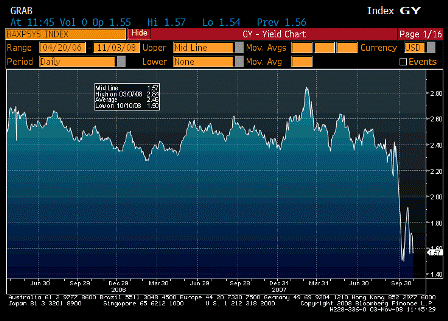
FWD Tips (-)
5 year 5 years forward was one of the Fed’s inflation expectation indicators.
It’s down, to where the Fed wants it to remain.
[top]

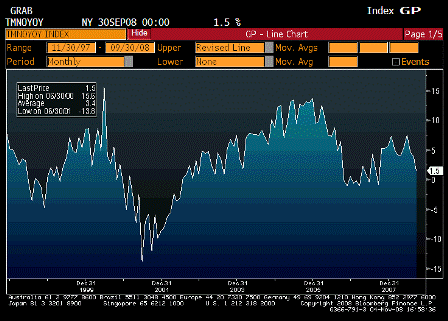
| Survey | n/a |
| Actual | 1.5% |
| Prior | 3.9% |
| Revised | n/a |
Dip down, but not terrible yet.
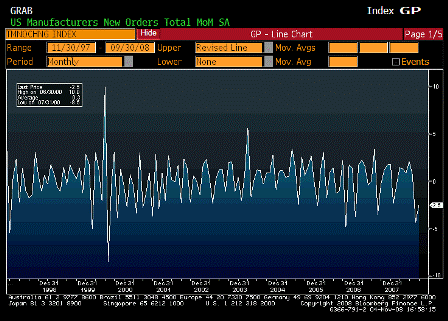
| Survey | n/a |
| Actual | -2.5% |
| Prior | -4.3% |
| Revised | n/a |
Down, but down less than last month.
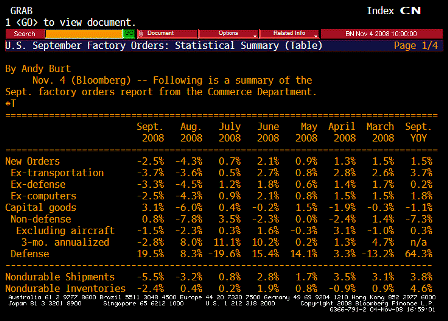
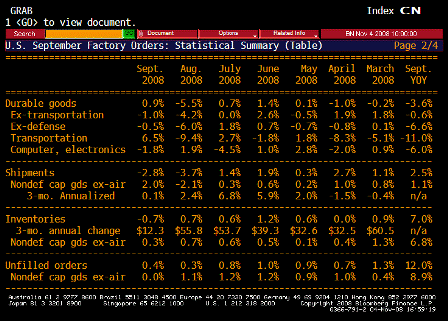
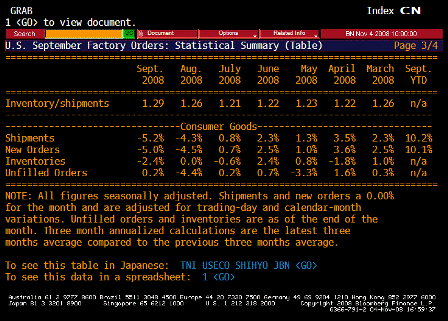
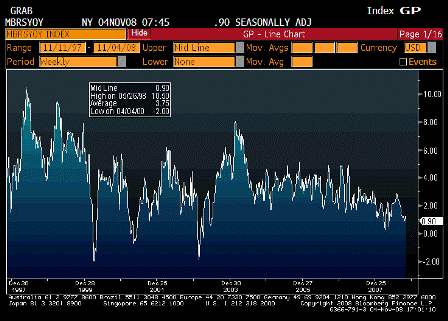
| Survey | n/a |
| Actual | .90% |
| Prior | 1.30% |
| Revised | n/a |
Looks to still be weakening but off the bottom and still positive.
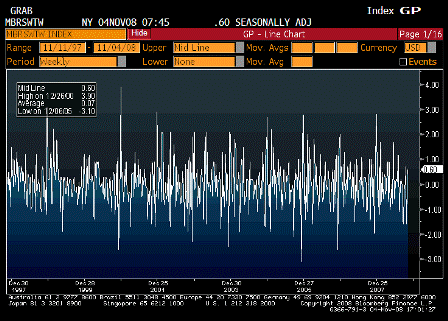
| Survey | n/a |
| Actual | 0.60% |
| Prior | 0.50% |
| Revised | n/a |
Same, still on the plus side.

| Survey | n/a |
| Actual | 0.30% |
| Prior | 0.70% |
| Revised | n/a |
Looking lower, but still off the recent lows.
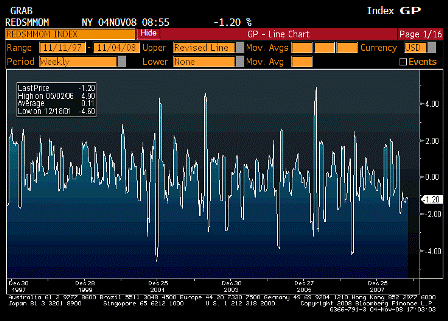
| Survey | n/a |
| Actual | -1.20% |
| Prior | -1.10% |
| Revised | n/a |
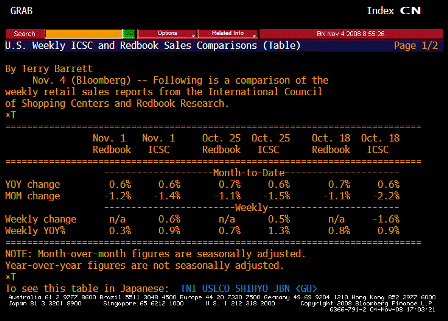
[top]
Much of the world seems to be going this way.
Enough fiscal will turn this around.
China’s Hu Calls for Efforts to Increase Demand, Xinhua Says
By Wang Ying
Nov. 1 (Bloomberg) — Chinese President Hu Jintao said the government needs to continue efforts to boost domestic demand to bolster financial stability and counter the impact of the global credit crisis, the state-run Xinhua News Agency reported.
The authorities will continue to consolidate the “foundational position” of agriculture and to deepen economic reforms and openness, Hu was quoted as saying. Hu spoke during a visit to the northwestern province of Shaanxi between Oct. 28 and Oct. 29, according to the report late yesterday.
China’s economy, the world’s fourth largest, expanded in the third quarter by 9 percent from a year earlier, the slowest pace since 2003. The government lowered interest rates three times in the past two months, increased export rebates and cut property transaction taxes.
[top]
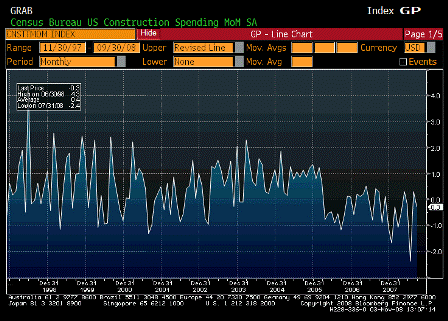
| Survey | -0.8% |
| Actual | -0.3% |
| Prior | 0.0% |
| Revised | 0.3% |
Better than expected and last month revised up.
Seems real estate is the only sector doing better than expected.
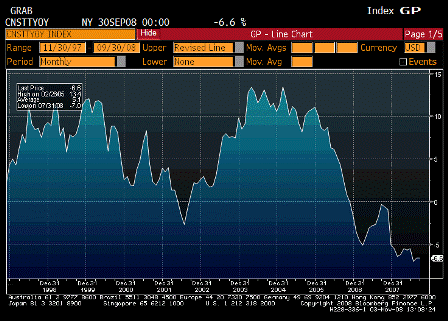
| Survey | n/a |
| Actual | -6.6% |
| Prior | -6.6% |
| Revised | n/a |
Still looking down, but seems to be leveling off.
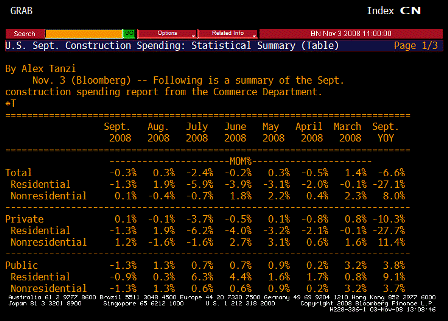
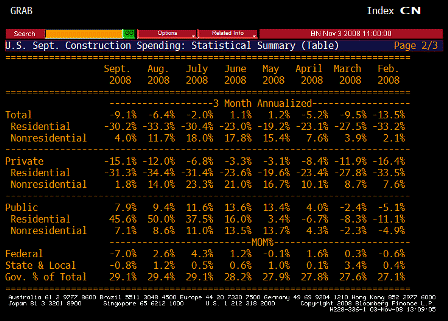
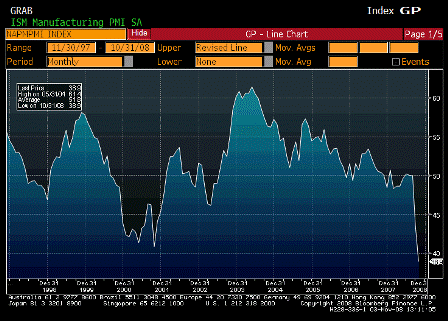
| Survey | 41.0 |
| Actual | 38.9 |
| Prior | 43.5 |
| Revised | n/a |
Fell off a cliff.
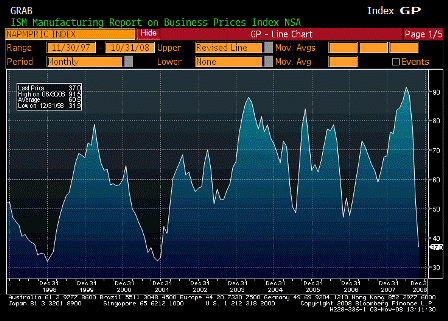
| Survey | 48.0 |
| Actual | 37.0 |
| Prior | 53.5 |
| Revised | n/a |
Also a very large drop.
[top]
Stability???


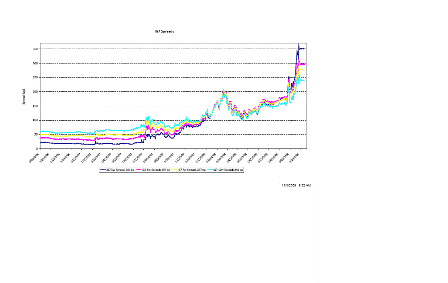
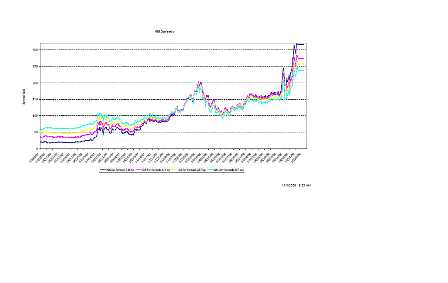
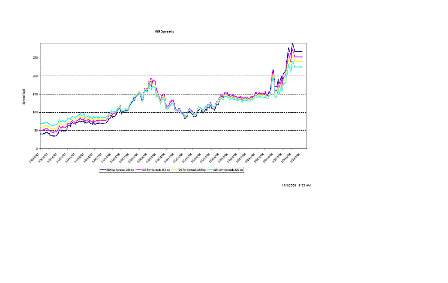
[top]
(email exchange)
Thanks!
>
> On Fri, Oct 31, 2008 at 7:25 AM, Bob wrote:
>
`Panic’ Strikes East Europe Borrowers as Banks Cut Franc Loans
By Ben Holland, Laura Cochrane and Balazs Penz
Oct. 31 (Bloomberg)- Imre Apostagi says the hospital upgrade he’s overseeing has stalled because his employer in Budapest can’t get a foreign-currency loan.
The company borrows in foreign currencies to avoid domestic interest rates as much as double those linked to dollars, euros and Swiss francs. Now banks are curtailing the loans as investors pull money out of eastern Europe’s developing markets and local currencies plunge.
Foreign-denominated loans helped fuel eastern European economies including Poland, Romania and Ukraine, funding home purchases and entrepreneurship after the region emerged from communism. The elimination of such lending is magnifying the global credit crunch and threatening to stall the expansion of some of Europe’s fastest-growing economies.
Plunging Currencies
Since the end of August, the forint has fallen 16 percent against the Swiss franc, the currency of choice for Hungarian homebuyers, and more than 8 percent versus the euro. Foreign- currency loans make up 62 percent of all household debt in the country, up from 33 percent three years ago.
That’s even after a boost this week from an International Monetary Fund emergency loan program for emerging markets and the U.S. Federal Reserve’s decision to pump as much as $120 billion into Brazil, Mexico, South Korea and Singapore. The Fed said yesterday that it aims to “mitigate the spread of difficulties in obtaining U.S. dollar funding.”
Plunging domestic currencies mean higher monthly payments for businesses and households repaying foreign-denominated loans, forcing them to scale back spending.
No More Dreaming
The bulk of eastern Europe’s credit boom was denominated in foreign currencies because they provided for cheaper financing.
Before the current financial turmoil, Romanian banks typically charged 7 percent interest on a euro loan, compared with about 9.5 percent for those in leu. Romanians had about $36 billion of foreign-currency loans at the end of September, almost triple the figure two years earlier.
In Hungary, rates on Swiss franc loans were about half the forint rates. Consumers borrowed five times as much in foreign currencies as in forint in the three months through June.
‘Serious Problems’
Now banks including Munich-based Bayerische Landesbank and Austria’s Raiffeisen International Bank Holding AG are curbing foreign-currency loans in Hungary. In Poland, where 80 percent of mortgages are denominated in Swiss francs, Bank Millennium SA, Getin Bank SA and PKO Bank Polski SA have either boosted fees or stopped lending in the currency.
The east has been the fastest-growing part of Europe, with Romania’s economy expanding 9.3 percent in the year through June, Ukraine 6.5 percent and Poland 5.8 percent. The combined economy of the countries sharing the euro grew 1.4 percent in the period.
IMF Help
Ukraine, facing financial meltdown as the hryvnia drops and prices for exports such as steel tumble, on Oct. 26 agreed to a $16.5 billion loan from the IMF.
Hungary on Oct. 28 secured $26 billion in loans from the IMF, the EU and the World Bank. The government forecast a 1 percent economic contraction next year, the first since 1993.
These come with ‘conditions’ which means contractionary fiscal adjustments.
Panicked Customers
Romanian central bank Governor Mugur Isarescu sounded the alarm in June, saying the growth of foreign-currency loans was “excessively high and risky,” especially because Romanians with their communist past aren’t used to the discipline of debt.
`Cheaper, Riskier’
Turkish savings in foreign currencies exceeded loans by about 30 percent as of the end of 2007, according to a January Fitch report. In Poland foreign exchange loans were double deposits, and in Hungary they were triple.
“We’ve been observing a return to a good old banking rule to lend in a currency in which people earn,” said Jan Krzysztof Bielecki, chief executive officer of Poland’s biggest lender, Bank Pekao SA. It stopped non-zloty lending in 2003. “Earlier, banks competed on the Swiss franc market watching only sales levels and not looking at keeping an acceptable risk level.”
[top]
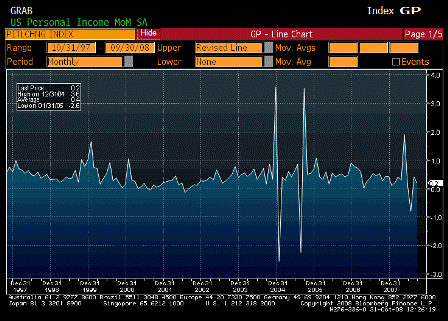
| Survey | 0.1% |
| Actual | 0.2% |
| Prior | 0.5% |
| Revised | 0.4% |
A tick better than expected but last month revised down same.
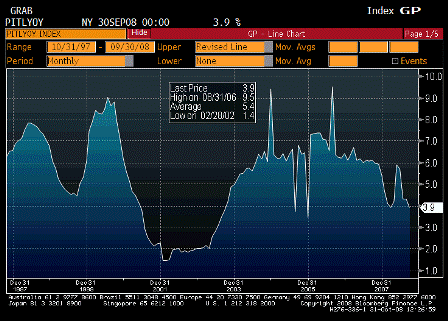
| Survey | n/a |
| Actual | 3.9% |
| Prior | 4.3% |
| Revised | n/a |
Looks to be on the decline as expected.
Lower interest rates are also a drag on income, as households are net savers.
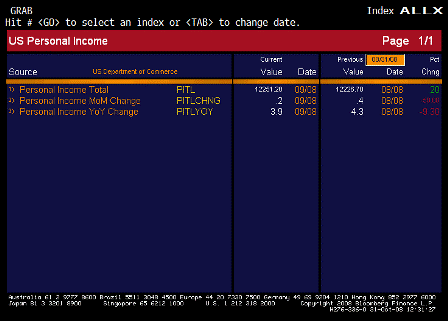
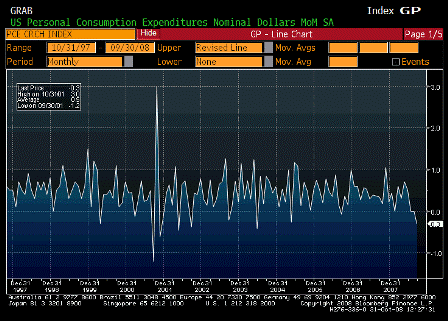
| Survey | -0.2% |
| Actual | -0.3% |
| Prior | 0.0% |
| Revised | n/a |
Worse than expected and took dive as the publicity around the credit crisis petrified businesses and consumers.
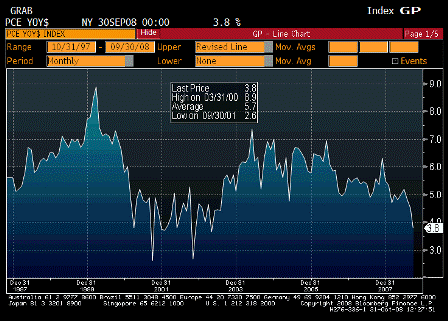
| Survey | n/a |
| Actual | 3.8% |
| Prior | 4.5% |
| Revised | n/a |
Heading south but still growing some.
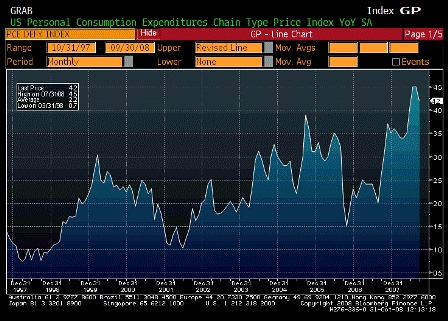
| Survey | 4.1% |
| Actual | 4.2% |
| Prior | 4.5% |
| Revised | n/a |
Higher than expected and staying high even with commodities coming down.
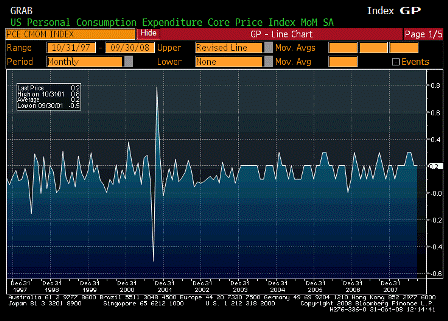
| Survey | 0.1% |
| Actual | 0.2% |
| Prior | 0.2% |
| Revised | n/a |
Higher than expected.
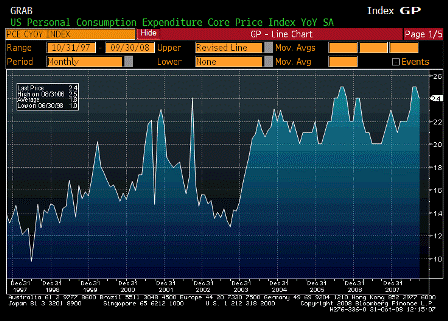
| Survey | 2.4% |
| Actual | 2.4% |
| Prior | 2.6% |
| Revised | 2.5% |
Holding firm, at least for now.
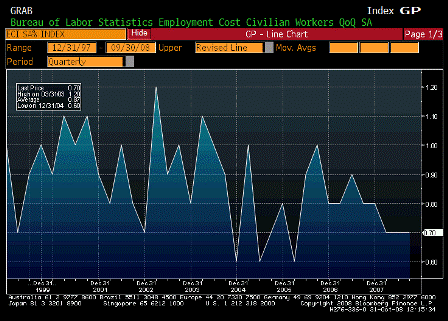
| Survey | 0.7% |
| Actual | 0.7% |
| Prior | 0.7% |
| Revised | n/a |
Well contained.
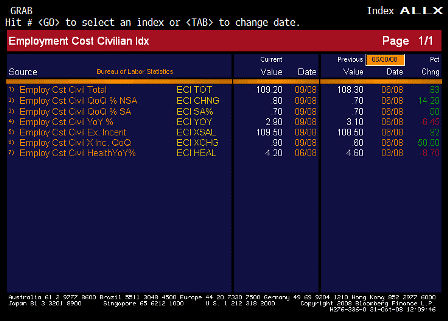
The surveys have a large subjective component, and have all taken dives recently.
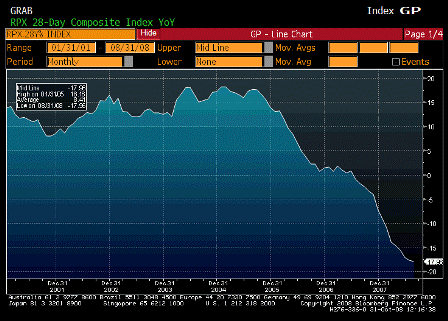
| Survey | n/a |
| Actual | -17.96% |
| Prior | -17.76% |
| Revised | n/a |
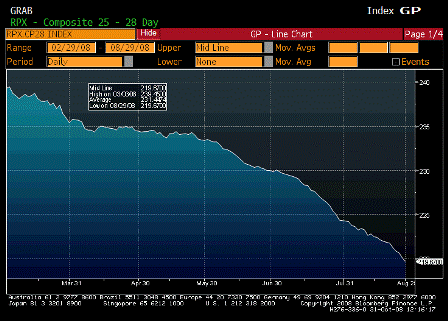
| Survey | n/a |
| Actual | 219.67 |
| Prior | 224.28 |
| Revised | n/a |
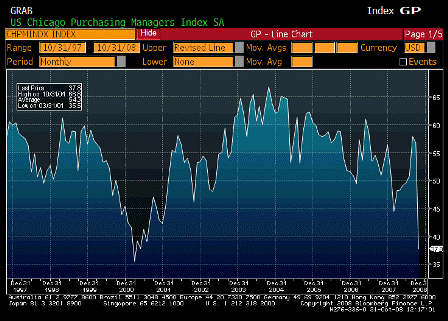
| Survey | 48.0 |
| Actual | 37.8 |
| Prior | 56.7 |
| Revised | n/a |
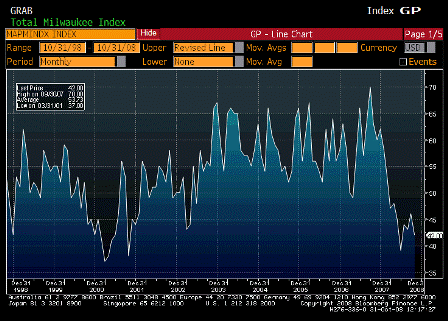
| Survey | n/a |
| Actual | 42.0 |
| Prior | 46.0 |
| Revised | n/a |
[top]
(email exchange)
>
> On Wed, Oct 29, 2008 at 11:45 PM, Morris wrote:
>
> This is the 64,000 dollar question…will unlimited FED lending to ENTIRE
> world-with IMF help-created recovery? Push on string? Hyper inflation?
> Question of the day…would love others inputs.
>
I’d say yes, it’s inflationary and the channels at least as follows:
1. The outstanding international dollar debt was an expansionary force when it was growing, to the extent the USD borrowings were spent. Some of that USD spending was overseas, some in the US.
Growing debt, if directed towards spending, is expansionary.
For example, you may borrow to build a house, or buy a new car.
But if you borrow to fund financial assets, your pension fund, or to buy mortgage backed securities, for example, it’s merely the rearranging of financial assets.
This increased ‘leverage’ and has no direct effect on demand, beyond the demand created by the financial institutions themselves. This includes all the hiring of employees for the financial sector which all counts as GDP.
(While this may not be deemed ‘useful output’ it is accounted for as GDP, like bridges to nowhere, and does function to support people’s livelihood. Yes, better to have employed them doing something deemed useful, but that’s another story)
2. Should the USD loans default, the financial institutions lose capital, meaning the shareholders (and bondholders, depending on the size of the loss) lose their nominal wealth. This may or may not reduce spending. Most studies say it’s a weak effect at best.
And for each institution to continue to function it needs to replace capital.
(In our ‘loans create deposits’ world, infinite capital is available at the right price, if the government has a policy to sustain domestic demand.)
For US institutions with USD denominated capital, losses result in a reduction of their USD capital.
Their liabilities remain the same, but their assets fall.
And any assets sold to reduce USD funding needs are sold for USD.
3. Institutions with capital denominated in other currencies, go through the same fundamental process but with another ‘step.’
When their USD assets are impaired, they are left with their USD liabilities.
They now have a ‘mismatch’ as non dollar assets including non dollar capital are supporting the remaining USD liabilities.
To get back to having their assets and liabilities matched in the same currency, they need to sell their assets in exchange for USD.
Until they do that they are ‘short’ USD vs their local currency, as a rising USD would mean they need to sell more of their local currency assets to cover their USD losses.
Technically, when the assets they need to sell to cover USD losses are denominated in non dollar currencies, this involves an FX transaction- selling local currency to buy USD- which puts downward pressure on their currencies.
Additionally, they need to continue to fund their USD financial assets, which can become problematic as the perception of risk increases.
4. The Fed’s swap lines ($522 billion outstanding, last i saw) help the rest of the world to fund themselves in USD.
In an effectively regulated environment, such as the US banking system, this works reasonably well but still carries a considerable risk that we decide to take as a nation for further public purpose. (it is believed the financial sector helps support useful domestic output, etc.)
Any slip up in regulation can result in the likes of the S&L crisis, and arguably the sub prime crisis, which results in a substantial disruption of real output and a substantial transfer of nominal and real wealth.
The Fed is lending to foreign CB’s in unlimited quantities, secured only by foreign currency deposits, to world banking systems it doesn’t regulate, and where regulation is for foreign public purpose.
The US public purpose of this is (best I can determine) to lower a foreign interest rate set in London called ‘LIBPR,’ and ‘perhaps’ to ‘give away’ USD to support US exports.
The Fed yesterday, for example, announced $30 billion of said lending to Mexico and Brazil for them to lend to their banks. The Fed must be a lot more comfortable with Mexico and Brazil’s bank regulation and supervision than I am, and certainly than Congress would be if they had any say in the matter.
5. The problem is that once the Fed provides funding to these foreign Central Banks, who then lend it all to their banking systems, they remove the foreign ‘funding pressure’ that was causing rates to be a couple of % higher over their (didn’t change our fed funds rate). Taking away the pressure takes away the incentives of the pressure to repay $US’s introduces.
The Fed is engaging in a major transfer of wealth from here to there. Initially its prevents the transfer of wealth back to the US, as would have happened if they had been forced to repay and eliminated their USD liabilities and losses.
That same force if continued develops into large increases in USD spending around the world as this ‘free money’ going to banking systems with even less supervision and regulation than ours soon ‘leaks out’ to facilitate increasing foreign consumption at the expense of USD depreciation.
Note the bias- the ECB gets an unlimited line and Mexico is capped at $30 billion.
This means the Fed is making a credit judgment of Mexico vs the ECB, which means the Fed is aware of the credit issue.
Conclusion, the Fed is beginning to recognize the swap lines are potentially explosively inflationary, as evidenced by not giving Mexico unlimited access.
The swap lines are also problematic to shut down should that start to happen, just like what shutting down lending to emerging markets did in the past.
Shutting down the swap lines would trigger the defaults that the unlimited funding had delayed, and then some, triggering a collapse in the world economies.
It’s a similar dynamic to funding state owned enterprises- the nominal costs go up and the losses go up as well should they get shut down.
Keeping them going is inflationary, shutting them down a major disruption to output and employment.
It is delaying the circumstances that were headed toward a shut down of the European payments system, but leaving the risks in place for the day the swap lines are terminated.
7. Bottom line- it looks to me that the swap lines are a continuation of the weak dollar policy Bernanke (student of the last gold standard depression) and Paulson have been pushing for the last couple of years.
This time they are ‘giving away’ dollars to foreigners, in unlimited quantities, ultimately to buy US goods and services.
They are doing this to support export led growth for the US, at the direct expense of our standard of living. (declining real terms of trade)
They are doing this to increase ‘national savings’- a notion applicable under the gold standard of the early 1930’s to prevent gold outflows, and where wealth is defined as gold hoards. This notion is totally non applicable to today’s convertible currency.
It is a failure to understand the indisputable Econ 101 fundamental that exports are real costs and imports real benefits.
They believe they are doing the right thing and that this is what’s good for us.
The unlimited swap lines are turning me into an inflation hawk longer term.
But the USD may not go down against all currencies, as potentially the inflation will hit other currencies as well.
Where to hide? I’m back to quality rental properties and energy investments.
The world is moving towards increased demand with no policy to make sure that doesn’t result in increased energy consumption and increasing inflation.
Comments welcome!
Warren
[top]
The Fed is able to unilaterally lend (functionally unsecured) $30 million each to Mexico and Brazil?!?!
There are far more sensible ways to restore prosperity.
Last figures I saw indicate $522 billion in these loans that have been advanced so far.
It’s looking more and more to me like this massive USD lending to foreign CB’s who reloan it to entities with the slimmest of collateral, is both a transfer of real wealth away from the US and a highly inflationary bias.
For the moment it’s halting deflation, but once unleashed there’s no telling where it will go.
Fed Opens Swaps With South Korea, Brazil, Mexico
By Steve Matthews and William Sim
Oct. 30 (Bloomberg) — The Federal Reserve agreed to provide $30 billion each to the central banks of Brazil, Mexico, South Korea and Singapore, expanding its effort to unfreeze money markets to emerging nations for the first time.
The Fed set up “liquidity swap facilities with the central banks of these four large systemically important economies” effective until April 30, the central bank said yesterday in a statement. The arrangements aim “to mitigate the spread of difficulties in obtaining U.S. dollar funding.”
[top]
The problem is the Fed doesn’t see the risks involved in this program.
They are only seeing ‘success’ as USD interest rates fall for lesser credits around the world.
The question is why they would want USD rates to come down for lower quality borrowers?
This policy does not reduce international USD borrowings.
Instead, it supports and encourages increased USD borrowings with attractive USD rates and terms.
And in unlimited quantities for the ECB, BOE, BOJ, and SNB.
Yes, unlimited USD lending to anyone who can breathe in and out lowers rates.
And as it’s going to several entities that will probably never pay it back, it’s the largest monetary handout/transfer of wealth of all time.
It’s also a policy that, once implemented, historically has become more than problematic to shut down.
US Fed launches four new currency swap lines
By David Lawder
WASHINGTON, Oct 29 (Reuters) – The Federal Reserve on Wednesday extended U.S. dollar liquidity aid beyond traditional markets, opening four new $30 billion currency swap lines with Brazil, Mexico, South Korea and Singapore.
The temporary arrangements, authorized through April 30, 2009, are aimed at easing global U.S. dollar funding shortages, the Fed said.
“These facilities, like those already established with other central banks, are designed to help improve liquidity conditions in global financial markets and to mitigate the spread of difficulties in obtaining U.S. dollar funding in fundamentally sound and well-managed economies,” the Fed said in a statement released in Washington.
The decision comes a day after the Fed established a $15 billion swap line with the Reserve Bank of New Zealand. The U.S. central bank now has 13 swap lines with foreign central banks.
[top]